What is in this leaflet
This leaflet answers some common questions about ELONVA.
It does not contain all the available information. It does not take the place of talking to your doctor or pharmacist.
All medicines have risks and benefits. Your doctor has weighed the risks of you using ELONVA against the benefits they expect it will have for you.
If you have any concerns about using this medicine, tell your doctor or pharmacist.
Keep this leaflet with the medicine. You may want to read it again.
What ELONVA is used for
ELONVA contains corifollitropin alfa, a medicine belonging to the group of gonadotrophic hormones. These hormones play an important part in human fertility and reproduction. One of these gonadotrophic hormones is follicle-stimulating hormone (FSH), which is needed in women for the growth and development of follicles (small round sacs in your ovaries that contain the eggs).
ELONVA is especially designed to work much longer than FSH. One single injection of ELONVA can replace a whole week of daily FSH injections in women participating in in vitro fertilisation (IVF).
ELONVA is used to help achieve pregnancy in women having infertility treatment, such as IVF. ELONVA causes the growth and development of several follicles at the same time by controlled stimulation of the ovaries. The eggs are collected from the ovary, fertilised in the laboratory and the embryos are transferred into the uterus a few days later.
ELONVA is not addictive.
Ask your doctor if you have any questions about why this medicine has been prescribed for you.
Before you use ELONVA
When you must not use it
Do not use ELONVA if you:
- are allergic (hypersensitive) to corifollitropin alfa or to any of the ingredients in ELONVA listed at the end of this leaflet.
- are pregnant or think you may be pregnant.
- are breastfeeding.
- have cancer of the ovary, breast, uterus, or brain (pituitary gland or hypothalamus).
- have recently had unexpected vaginal bleeding (other than periods) where the cause is unknown.
- have ovaries that do not work because of a condition called primary ovarian failure.
- have ovarian cysts or enlarged ovaries.
- have malformations of the sexual organs which make a normal pregnancy impossible.
- have fibroid tumours in the uterus which make a normal pregnancy impossible.
- have risk factors of OHSS (OHSS is a serious medical problem that can happen when the ovaries are overly stimulated. See below for further explanation):
- have polycystic ovarian syndrome (PCOS)
- have had ovarian hyperstimulation syndrome (OHSS)
- have previously had a treatment cycle of controlled stimulation of the ovaries that resulted in the growth of more than 30 follicles with a size of 11 mm or larger
- have a basal antral follicle count (the number of small follicles present in your ovaries at the beginning of a menstrual cycle) higher than 20
Do not use ELONVA:
- if the syringe or needle is damaged
- if the solution is not clear
- if the packaging is torn or shows signs of tampering
- after the expiry date printed on the pack has passed
If it has expired or is damaged, return it to your pharmacist or clinic.
If you are not sure whether you should start using ELONVA, talk to your doctor.
Before you start to use it
Take special care with ELONVA
Before starting to use this medicine, tell your doctor if you:
- have ever had ovarian hyperstimulation syndrome (OHSS)
- are pregnant or think you might be pregnant
- have ever had stomach (abdominal) surgery
- have ever had a twisting of an ovary (ovarian torsion). Twisting of an ovary could cause the blood flow to the ovary to be cut off.
- have past or current cysts in you ovary or ovaries
- have kidney disease
- have uncontrolled pituitary gland or hypothalamic problems
- have an underactive thyroid (hypothyroidism)
- have adrenal glands that are not working properly (adrenocortical insufficiency)
- have high prolactin levels in the blood (hyperprolactinemia)
- have any other medical conditions (for example, diabetes, heart disease, or any other long-term disease)
- have been told by a doctor that pregnancy would be dangerous for you
Ovarian Hyperstimulation Syndrome (OHSS)
Treatment with gonadotrophic hormones like ELONVA may cause ovarian hyperstimulation syndrome (OHSS). This is a serious medical condition where the ovaries are overly stimulated and the growing follicles become larger than normal.
OHSS causes fluid to build up suddenly in your stomach and chest areas and can cause blood clots to form.
Call you doctor right away if you have:
- severe abdominal swelling and pain in the stomach area (abdomen)
- feeling sick (nausea)
- vomiting
- sudden weight gain due to fluid build up
- diarrhoea
- decreased urine output
- trouble breathing
In rare cases, severe OHSS may be life-threatening. Therefore close supervision by your doctor is very important. To check the effects of treatment, your doctor will do ultrasound scans of your ovaries. Your doctor may also check blood hormone levels (see also Side Effects).
Use ELONVA only once during the same treatment cycle otherwise the chance of having OHSS may increase.
Thrombosis (blood clot)
Treatment with gonadotrophic hormones like ELONVA may (as in pregnancy) increase the risk of having a blood clot (thrombosis). Thrombosis is the formation of a blood clot in a blood vessel.
Blood clots can cause serious medical conditions, such as:
- blockage in your lungs (pulmonary embolus)
- stroke
- heart attack
- blood vessel problems (thrombophlebitis)
- a lack of blood flow (deep venous thrombosis) that may result in a loss of your arm or leg
Please discuss this with your doctor, before starting treatment, especially if:
- you know you already have an increased chance of having a thrombosis
- you, or anyone in your immediate family, have ever had a thrombosis
- you are severely overweight
Multiple pregnancies
In women having fertility treatment, the risk of multiple pregnancies (having twins or even more than two babies) is mainly related to the number of embryos transferred into the uterus.
Multiple pregnancies carry an increased health risk for both the mother and her babies. Multiple pregnancies and specific characteristics of couples with fertility problems (e.g. a woman's age, certain sperm problems, genetic background of both parents) may also be associated with an increased chance of birth defects.
Pregnancy complications
If treatment with ELONVA results in pregnancy, there is a higher chance of pregnancy outside the uterus (an ectopic pregnancy). Therefore your doctor should perform an early ultrasound examination to exclude the possibility of pregnancy outside the uterus.
Ovarian and other reproductive system tumours
There have been reports of ovarian and other reproductive system tumours in women who have had infertility treatment. It is not known if treatment with fertility medicines increases the risk of these tumours in infertile women.
Taking other medicines
Tell your doctor if you are taking or have recently taken any other medicines, including any that you get without a prescription from your pharmacy, supermarket or health food shop.
How to use ELONVA
Follow all directions given to you by your doctor, nurse or pharmacist carefully. You should check with your doctor or pharmacist if you are not sure.
Treatment with ELONVA should be started under the supervision of a specialist doctor experienced in fertility treatment.
How much to inject
In the treatment of women of reproductive age, the dose of ELONVA is based on weight and age.
A single 100 - microgram dose is recommended in women who weigh less than or equal to 60 kilograms and who are 36 years of age or younger.
A single 150 - microgram dose is recommended in women:
- who weigh more than 60 kilograms, regardless of age.
- who weigh 50 kilograms or more and who are older than 36 years of age.
Women older than 36 years of age who weighed less than 50 kilograms were not studied.
Your doctor will explain exactly when to give the injection.
Your doctor may also give you other medication (such as a GnRH antagonist) to prevent early release of eggs from your ovary.
Seven days after the injection of ELONVA, your doctor may decide to continue your treatment cycle with another gonadotrophic hormone, like follicle-stimulating hormone (FSH) medicine. This may be continued for a few days until enough follicles of adequate size are present. This can be checked by ultrasound examination. FSH treatment is then stopped and the eggs are matured by giving hCG (human Chorionic Gonadotrophin). The eggs are collected from the ovary 34-36 hours later.
How to inject
ELONVA must be injected under the skin (subcutaneous) into a skin fold (that you pinch between your thumb and index finger), preferably just below the navel.
Do not inject ELONVA into a muscle.
The doctor or nurse may give you the injection.
ELONVA can also be injected by yourself or by your partner.
If the doctor decides you can give the injection yourself, the doctor or nurse will teach you the injection technique.
A step-by-step "instructions for use" is given at the end of this leaflet.
Do not attempt self-injection until you are sure of how to do it. Your partner may be trained to give the injection at home.
ELONVA is supplied in pre-filled syringes that have an automatic safety system to help prevent needle stick injuries after use.
If you forget to inject ELONVA
Contact your doctor immediately if you forget to inject ELONVA on the day you should have. Do not inject ELONVA without talking to your doctor.
If you use too much (overdose)
Contact your doctor immediately if you think you have used more ELONVA or additional medicines (for example, follicle-stimulating hormone) that make your ovaries continue to grow mature eggs.
While you are using ELONVA
Your doctor will carefully monitor your response using ultrasound scans of your ovaries during treatment with ELONVA. Your doctor may also check blood hormone levels.
Things you must do
See your doctor regularly so you can be monitored closely throughout your treatment.
If you are about to be started on any new medicine, tell your doctor and pharmacist that you are taking ELONVA.
If you plan to have surgery, tell your doctor or dentist that you are using ELONVA.
Tell all doctors and dentists who are treating you that you are using ELONVA.
Things you must not do
Be careful driving or operating machinery until you know how ELONVA affects you. ELONVA may cause dizziness. If you feel dizzy, you should not drive a car, operate machinery or do anything else that could be dangerous.
Do not give your medicine to anyone else, even if they have the same condition as you.
Side effects
Tell your doctor as soon as possible if you do not feel well while you are taking ELONVA.
All medicines can have side effects. Sometimes they are serious, most of the time they are not. You may need medical treatment if you get some of the side effects.
Common (affects 1 to 10 users in 100):
- Ovarian hyperstimulation syndrome (OHSS)
- Pelvic pain
- Feeling sick (nausea)
- Headache
- Tiredness (fatigue)
- Pelvic discomfort
- Breast tenderness
Uncommon (affects 1 to 10 users in 1,000):
- Ovarian torsion (twisting of the ovary resulting in extreme lower stomach pain)
- Liver enzyme increases
- Miscarriage
- Pain after oocyte retrieval
- Procedural pain
- Releasing an egg too early (premature ovulation)
- Abdominal distension
- Vomiting
- Diarrhoea
- Constipation
- Back pain
- Breast pain
- Bruising or pain at the injection site
- Irritability
- Mood swings
- Dizziness
- Hot flush
A possible complication of treatment with gonadotrophic hormones like ELONVA is unwanted overstimulation of the ovaries.
The chance of having this complication can be reduced by carefully monitoring the number of maturing follicles. Your doctor will do ultrasound scans of your ovaries to carefully monitor the number of maturing follicles. Your doctor may also check blood hormone levels.
The first symptoms of ovarian overstimulation may be noticed as: pain in the stomach (abdomen), feeling sick or diarrhoea.
Ovarian overstimulation may develop into a serious medical condition called ovarian hyperstimulation syndrome (OHSS). Signs and symptoms of severe OHSS may include:
- acute stomach pain, weight gain, shortness of breath and passing less urine.
- in rare cases blood clots. Signs of a blood clot include pain, warmth, redness, numbness or tingling in your arm or leg.
Tell your doctor immediately or go to the accident and emergency at your nearest hospital if you have stomach pains or any of the other symptoms of ovarian hyperstimulation, even if they happen some days after the injection has been given.
In general use there have been reports of allergic reactions (hypersensitivity reactions, both local and generalised, including rash).
The following side effects are considered to be related to Assisted Reproductive Technology (ART) or subsequent pregnancy.
- ectopic pregnancy (pregnancy that occurs outside the uterus)
- multiple pregnancies
The incidence of congenital malformations (a physical defect present in a baby at birth) after ART may be slightly higher than after spontaneous conceptions. The slightly higher incidence is thought to be due to differences in patients undergoing fertility treatment (e.g. age of the female, sperm characteristics) and to the higher incidence of multiple pregnancies after ART.
Tell your doctor if you notice anything that is making you feel unwell.
Other side effects not listed above may occur in some patients.
After using it
Storage
Store ELONVA in the refrigerator (2°C to 8°C) until the expiry date. Do not freeze.
Do not use after the expiry date on the carton.
OR
Store at or below 25°C for a total period of not more than one month. Make a note of when you start storing the product out of the refrigerator, and use it within one month of that date.
Keep the syringe in the outer carton in order to protect from light until you are ready to use it.
Keep ELONVA in a safe place away from the sight and reach of children.
Do not use ELONVA:
- If it has been stored out of the refrigerator for more than one month.
- If it has been stored out of the refrigerator at a temperature of more than 25°C.
Disposal
Do not dispose of an empty or unused syringe in household waste.
Ask your pharmacist or doctor how to dispose of medicines no longer required. These measures will help protect the environment.
Product description
What it looks like
ELONVA is a clear and colourless solution in a pre-filled syringe for single use.
The syringe has an automatic safety system, which prevents needle stick injuries after use.
One pre-filled syringe contains 100 micrograms or 150 micrograms of corifollitropin alfa in 0.5 mL.
ELONVA is available in packs containing 1 pre-filled syringe and a sterile injection needle.
Ingredients
Active ingredient
- corifollitropin alfa (rch)
Inactive ingredients
- sodium citrate dihydrate
- sucrose
- polysorbate 20
- methionine
- water for injections
- sodium hydroxide and/or hydrochloric acid for adjustment of pH.
ELONVA contains less than 1 mmol sodium (23 mg) per injection, i.e. essentially "sodium-free".
Supplier
Organon Pharma Pty Ltd
Building A
26 Talavera Road
Macquarie Park NSW 2113
Australia
Organon New Zealand Limited
P O Box 99 851
Newmarket
Auckland 1149
New Zealand
Australian Registration Numbers:
AUST R 160646 (100 mcg/0.5 mL)
AUST R 160645 (150 mcg/0.5 mL)
Date of preparation: January 2021
Instructions for use
Components of the ELONVA syringe with needle:

Preparing the injection
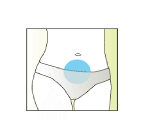
- Wash your hands with soap and water and dry them before you use ELONVA.
Swab the injection site (the area just below your belly button) with a disinfectant (for example, alcohol) to remove any surface bacteria.
Clean about 5 cm around the point where the needle will go in and let the disinfectant dry for at least one minute before proceeding.
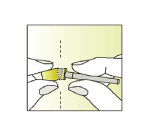
- While waiting for the disinfectant to dry, break the label perforation and pull off the needle-cap.
Leave the needle shield on the needle.
Place the needle shield (containing the needle) on a clean dry surface, while preparing the syringe.
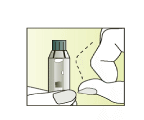
- Hold the syringe with the grey cap pointing upwards.
Tap the syringe gently with your finger to help air bubbles rise to the top.
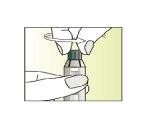
- Keep the syringe pointing upwards.
Unscrew the syringe cap counter-clockwise.
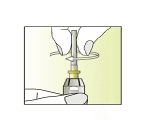
- Keep the syringe pointing upwards.
Screw the needle shield (containing the needle) clockwise onto the syringe.
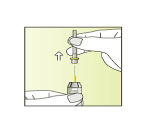
- Keep the syringe pointing upwards.
Remove the needle shield straight up and discard it.
BE CAREFUL with the needle.
Injecting
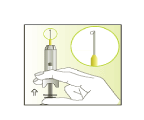
- Now take the syringe between index and middle finger in the upward position.
Place your thumb on the plunger.
Carefully push the plunger upwards until a tiny droplet appears at the tip of the needle.
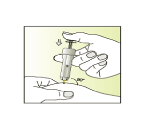
- Pinch a fold of the skin between thumb and index finger.
Insert the entire needle at an angle of 90 degrees into the fold of the skin.
CAREFULLY press the plunger until it can not go further and hold the plunger down
COUNT TO FIVE to ensure that all of the solution is injected.
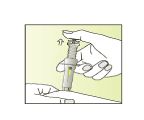
- Release your thumb from the plunger.
The needle will withdraw automatically into the syringe where it will be locked permanently.
Published by MIMS April 2021

 The recommended doses of Elonva have only been established in a treatment cycle with a GnRH antagonist that was administered from stimulation day 5 or day 6 onwards (see Section 4.4 Special Warnings and Precautions for Use; Section 5.1 Pharmacodynamic Properties, Clinical trials).
The recommended doses of Elonva have only been established in a treatment cycle with a GnRH antagonist that was administered from stimulation day 5 or day 6 onwards (see Section 4.4 Special Warnings and Precautions for Use; Section 5.1 Pharmacodynamic Properties, Clinical trials). There have been post-marketing reports of hypersensitivity reactions, both local and generalised, including rash.
There have been post-marketing reports of hypersensitivity reactions, both local and generalised, including rash.
 In these clinical trials, the safety profile of a single injection of Elonva was comparable to daily injections with recFSH.
In these clinical trials, the safety profile of a single injection of Elonva was comparable to daily injections with recFSH.


